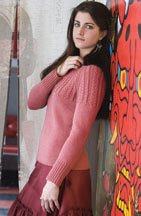Maryanne advertised me so well, but I am not sure if what I have to say is really so inventive. I am the kind of knitter who, first of all, can't follow the pattern (because I always have to change the neckline, shorten or prolong something) and second I never in my life used the yarn suggested in the pattern. Mostly because I always knitted from German/English publications and the yarns mentioned there weren't available in Poland or in Switzerland. So, substituting yarn became rather essential to my knitting. The simplest method I use is first to check what kind of yarn is required - the most important is how thick your knitting needles should be. Then check how many yards or meters you need. Now, if a pattern calls for yarn which requires needles size 4 (4mm, sorry have no idea about the American system- Maryanne, if you can tell better, please edit me!) you can easily go with another yarn requiring the same size or one size bigger or smaller. All depends on what effect you want to achieve. Let's say that a pattern suggests merino, but for some reason you don't like wool or just want a lighter sweater: you can easily pick up cotton (for a smooth and tight fit) or cotton/viscose, cotton/silk (for a more glossy look) or any other blend of yarn (even the sale yarn, because it's cheap and looks fab!) as long as the size of needles stays the same. Again, you have to know your knitting: if you knit loose, you might check for needles a size smaller, in order to keep to get your chosen garment to look as you want. If you knit tight (like I do), think about using bigger needles, otherwise your garment will be stiff and tight. Keeping the size of the needles is as well rather useful with counting the yardage. Recently I learned to buy yarn not by skeins (as most of the European magazines call for) but by yardage, and it always works! No more 1-2 skein rests, with which one has no idea what to do! So if the pattern says 1000y and your gauge is close to the pattern's gauge, you will probably need 1000y of the substituted yarn. I usually allow myself 100-200y extra, but again: I am paranoid and very careful. Plus, with the yarn delivery in this strange country it's always better to have one skein extra. If your gauge is bigger you should probably anyway decide to have 200y more.
Of course, depending on what blend you use, your knit will look different. For instance, I am working right now on the Puff Cardigan from "Fitted Knits". The pattern called for merino, but I didn't have any in the stash and didn't feel like spending extra money on this project. I had some nice cotton, which as well was to be knitted on the needles size 4-4,5mm. Knowing me and knitting from this kind of yarn (which is weaved from 7 thin cotton threads and then twisted into a loose kind of cord, so it splits like hell... but it has a lovely matt-gloss look and an adorable colour) I decided for needles size 4. The cardigan on the picture in the book looks rather tightly knitted, and it gives me the impression of being almost felted. But my cotton gave extra dimension to the knits. The seed stitch looks almost like beaded and the whole knit seems to be more decorative, almost decadent.
As some of you might know I knitted two different versions of Lelah: one in cotton and one in poly blend. And believe me or not, they look completely different. The one from cotton is slightly too big in the boob area, but it's because I didn't trust the pattern. The poly one is my absolute favourite, because it as well wears better than this particular cotton yarn.
When you substitute yarn, you have to make sure that your gauge is right. I never start work without making a swatch or two (with needles of two different sizes, to compare which I like better). Like that one can easily count the stitches required for the particular project. (I know I am not telling anything new). I usually cast on 20 stiches for my swatch (sometimes more, depending on what the label says). Now: if your garment is knitted in stockinette you should knit the swatch in stockinette (but if it's patterned, then better make a swatch in the pattern you will knit in, and a stockinette to make sure it's not too loose). I am a lazy swatcher and keep it short, usually about 20 rows. Then measure how many inches/centimeters you get in those 20s. And now it gets very mathy: let's say that your 20s=12cm/4.72 inches, but the pattern says you need 48cm/18.9inch. Here you count like that: 20 times 48=960, 960 divided by 12=80 stitches (20 times 18.9 = 378, 378 divided by 4.72 = 80 stitches). So that's the amount of stitches which you need to obtain the gauge. But again, some patterns call for a particular amount of stitches to keep the repeats of the pattern. So, if our gauge is 80 stitches but we have to work on the pattern which repeats over 13stitches, then: 80 divided by 13 = 6,2 repeats, so round it up to 7 repeats (so that the garment wouldn't be too tight) and that gives you 13 times 7 = 91 stitches. Does it make sense?
I know, ladies, that probably all of you knew this stuff already, so I hope that I haven't bored you to death!
Happy Knitting!
Subscribe to:
Post Comments (Atom)






No comments:
Post a Comment